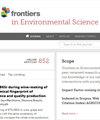澳大利亚克服使用基于自然的海岸保护障碍的蓝图
IF 3.3
3区 环境科学与生态学
Q2 ENVIRONMENTAL SCIENCES
引用次数: 0
摘要
全球沿海栖息地的丧失使社区面临侵蚀和洪水的风险,同时也影响了生态系统功能、文化价值、生物多样性和其他服务。沿海栖息地恢复可以提供一种基于自然的解决方案,在恢复丧失的生态系统的同时,满足沿海地区日益增长的气候适应需求。尽管利用基于自然的海岸保护来管理海岸灾害有很多好处,但广泛使用这种方法还存在科学、社会政治和经济方面的障碍。从多方利益相关者的角度了解这些障碍的细节,对于找到克服这些障碍的解决方案至关重要。通过与海岸保护解决方案的管理、设计和交付方面的主要合作伙伴和利益相关者(来自政府、工程咨询公司和非政府组织)举办研讨会,我们的目标是(1) 更好地了解参与实施基于自然的海岸保护的多方利益相关者所面临的障碍;(2) 针对这些障碍确定切实可行的解决方案,以增加或支持实施,帮助关注未来研究的领域,并为基于自然的海岸保护的治理提供参考路径。我们为基于自然的海岸保护定义了 19 个障碍,但在项目实施过程中遇到的主要障碍是缺乏:教育和意识;社区支持;必要的专业知识和技术指导;以及围绕以下方面的不确定性:可实现的风险降低;规划和监管过程;以及结构的所有权。有两个障碍在项目的设计阶段并不存在,但对是否首先考虑以自然为基础的海岸保 护至关重要,它们是政府的支持和资金的可获得性。这些主要障碍的重要性会随着基于自然的海岸保护方法的不同而变化。最后,我们针对每个主要障碍,提出了实现基于自然的沿岸保护的近期行动和长期解决 方案。本文章由计算机程序翻译,如有差异,请以英文原文为准。
A blueprint for overcoming barriers to the use of nature-based coastal protection in Australia
The global loss of coastal habitats is putting communities at risk of erosion and flooding, as well as impacting ecosystem function, cultural values, biodiversity, and other services. Coastal habitat restoration can provide a nature-based solution to the increasing need for climate adaptation on the coast while recovering lost ecosystems. Despite the benefits of using nature-based coastal protection to manage coastal hazards, there are scientific, socio-political and economic barriers to the broad use of this approach. Understanding the details of these barriers from the perspective of multiple stakeholders is essential to identifying solutions to overcome them. Using a workshop with participants that are key partners and stakeholders (from government, engineering consulting firms, and non-governmental organisations) in the management, design, and delivery of a coastal protection solution we aimed to: (1) gain a better understanding of the barriers faced by multiple stakeholders involved in the implementation of nature-based coastal protection; and (2) identify tangible solutions to these barriers to increase or support implementation, help focus attention on areas for future research, and inform pathways forward for the governance of nature-based coastal protection. We defined 19 barriers to nature-based coastal protection, but the primary ones that are experienced during the delivery of a project are a lack of: education and awareness; community support; necessary expertise and technical guidance; and uncertainty around: the risk reduction that can be achieved; planning and regulatory processes; and ownership of the structure. Two barriers that do not persist during the design stages of a project but are overarching as to whether nature-based coastal protection is considered in the first place, are government support and the availability of funding. The importance of these primary barriers changes depending on the method of nature-based coastal protection. We conclude by identifying both immediate actions and long-term solutions for enabling nature-based coastal protection in response to each of the primary barriers.
求助全文
通过发布文献求助,成功后即可免费获取论文全文。
去求助
来源期刊

Frontiers in Environmental Science
Environmental Science-General Environmental Science
CiteScore
4.50
自引率
8.70%
发文量
2276
审稿时长
12 weeks
期刊介绍:
Our natural world is experiencing a state of rapid change unprecedented in the presence of humans. The changes affect virtually all physical, chemical and biological systems on Earth. The interaction of these systems leads to tipping points, feedbacks and amplification of effects. In virtually all cases, the causes of environmental change can be traced to human activity through either direct interventions as a consequence of pollution, or through global warming from greenhouse case emissions. Well-formulated and internationally-relevant policies to mitigate the change, or adapt to the consequences, that will ensure our ability to thrive in the coming decades are badly needed. Without proper understanding of the processes involved, and deep understanding of the likely impacts of bad decisions or inaction, the security of food, water and energy is a risk. Left unchecked shortages of these basic commodities will lead to migration, global geopolitical tension and conflict. This represents the major challenge of our time. We are the first generation to appreciate the problem and we will be judged in future by our ability to determine and take the action necessary. Appropriate knowledge of the condition of our natural world, appreciation of the changes occurring, and predictions of how the future will develop are requisite to the definition and implementation of solutions.
Frontiers in Environmental Science publishes research at the cutting edge of knowledge of our natural world and its various intersections with society. It bridges between the identification and measurement of change, comprehension of the processes responsible, and the measures needed to reduce their impact. Its aim is to assist the formulation of policies, by offering sound scientific evidence on environmental science, that will lead to a more inhabitable and sustainable world for the generations to come.
 求助内容:
求助内容: 应助结果提醒方式:
应助结果提醒方式:


